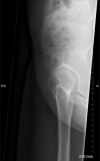Assessment of the young adult hip joint using plain radiographs
- PMID: 32125641
- PMCID: PMC7686009
- DOI: 10.1007/s12306-020-00650-2
Assessment of the young adult hip joint using plain radiographs
Abstract
Radiographic examination remains the mainstay of the initial assessment of the young adult hip; however, common parameters are required to assist in the formation of accurate diagnoses and appropriate management plans. This paper aims to summarise the most important aspects of the assessment of plain radiographs performed on the young adult hip joint.
Keywords: Assessment; Hip joint; Radiographs; Young adult.
Conflict of interest statement
None.
Figures















References
Publication types
MeSH terms
LinkOut - more resources
Full Text Sources

